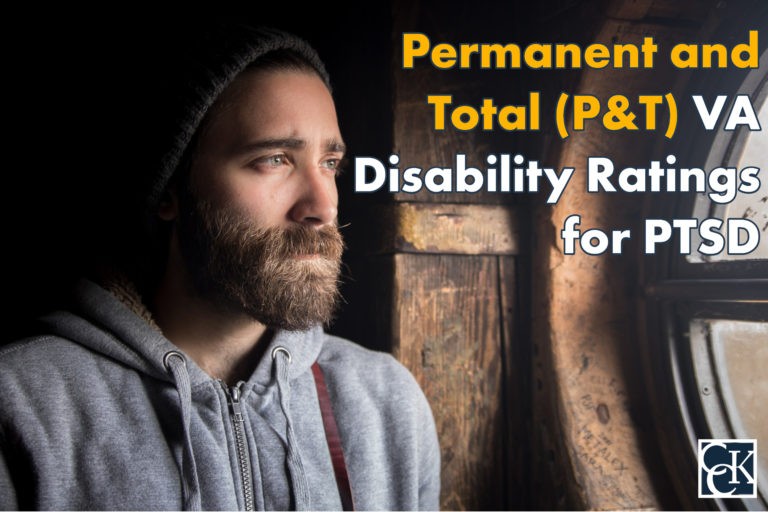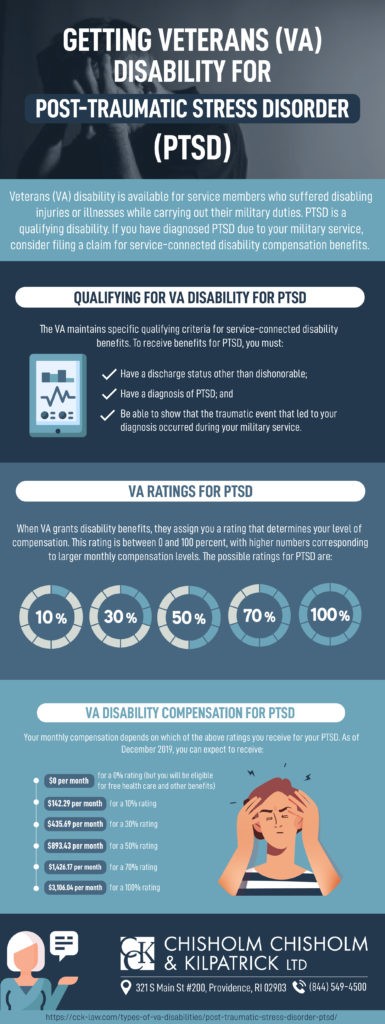Permanent and Total (P&T) VA Disability Ratings for PTSD

CCK Law: Our Vital Role in Veterans Law
Many veterans develop post-traumatic stress disorder, or PTSD, from events they witnessed or experienced during their military service. PTSD can either be short-term or chronic depending on the individual and the circumstances.
If a veteran is experiencing total occupational and social impairment due to their chronic post-traumatic stress disorder, they may qualify for U.S. Department of Veterans Affairs (VA) permanent and total disability for PTSD.
Continue reading to find out when PTSD is considered permanent by VA and in what circumstances it is rated 100 percent disabling.
What is Post-Traumatic Stress Disorder (PTSD)?
Post-traumatic stress disorder (PTSD) is a mental health condition that occurs as a result of experiencing a distressing, shocking, or otherwise traumatic event.
Symptoms of PTSD usually begin within three months of the traumatic incident, though sometimes they can take years to develop. The symptoms and severity of PTSD can vary from person to person.
To receive a diagnosis of PTSD, symptoms must last more than one month and be severe enough to interfere with day-to-day life, relationships, or work. PTSD can be diagnosed by a medical professional, whether it be a therapist, psychiatrist, or general practitioner.
PTSD diagnostic criteria are separated into four categories of symptoms:
- Re-experiencing symptoms – flashbacks, nightmares, and intrusive thoughts.
- Avoidance symptoms – staying away from places, events, or objects that are reminders of the traumatic experience and avoiding thoughts or feelings related to the traumatic event.
- Arousal and reactivity symptoms – being easily startled, feeling tense or on edge, having difficulty sleeping, and having angry outbursts.
- Cognition and mood symptoms – trouble remembering key features of the traumatic event, negative thoughts about oneself or the world, distorted feelings like guilt or blame, and loss of interest in enjoyable activities.
The main treatments for people with post-traumatic stress disorder are medications (e.g., antidepressants), psychotherapy (talk therapy), or both.

VA Disability Ratings for PTSD
To secure PTSD disability compensation from VA, veterans must establish service connection by showing evidence of the following three things:
- A current diagnosis of PTSD by a medical professional;
- An in-service stressor (i.e., a traumatic event or incident during military service that caused PTSD); and
- A medical nexus linking the current, diagnosed PTSD to the in-service stressor.
After service connection for PTSD is established, VA will assign a disability rating. To determine a disability rating, VA uses the General Rating Formula for Mental Disorders under 38 CFR § 4.130.
PTSD can be rated a 0, 10, 30, 50, 70, or 100 percent, depending on the severity of symptoms.
Are PTSD Ratings Permanent?
In most cases, disability ratings for the condition may be subject to change. For example, if a veteran’s PTSD worsens over time, they can file for an increased rating. On the other hand, if VA finds that a veteran’s PTSD has improved since the initial rating, there are some situations in which their disability rating can be reduced.
Under certain circumstances, veterans may be assigned a permanent and total (P&T) disability rating for PTSD, which guarantees full monthly compensation for the remainder of the veteran’s life.
What Is Permanent and Total (P&T) VA Disability?
Permanent and total (P&T) disability refers to veterans with disabilities that are:
- Permanent: rated 100 percent disabling by VA; and
- Total: have zero or close to zero chance of improvement.
Though “permanent and total” is often used as a single phrase, veterans can have a total disability that is temporary or a permanent disability rated less than 100 percent.
P&T ratings are protected from being reduced and may entitle veterans and their families to additional VA benefits.
Permanent VA Disability
VA deems a disability permanent when it is reasonably certain, based on medical evidence, that the level of impairment will continue for the rest of the veteran’s life. For this reason, VA often takes age into account when determining whether a disability is permanent. Therefore, it can be more difficult for younger veterans to be considered permanently disabled.
Total VA Disability
Veterans’ conditions are rated based on VA’s Schedule of Rating Disabilities. The rating levels for each condition are based on how much a veteran’s symptoms impair their veteran’s ability to function in daily life and at work. A 100 percent rating indicates that a condition is completely, or totally, disabling.

VA Permanent and Total (P&T) Disability for PTSD
A PTSD disability rating may become permanent and total if VA determines that it meets the 100 percent criteria set forth by the rating schedule and there is zero chance of improvement.
VA’s rating criteria for 100 percent disability for PTSD are as follows:
- 100% – “Total occupational and social impairment, due to such symptoms as: gross impairment in thought processes or communication; persistent delusions or hallucinations; grossly inappropriate behavior; persistent danger of hurting self or others; intermittent inability to perform activities of daily living (including maintenance of minimal personal hygiene); disorientation to time or place; memory loss for names of close relatives, own occupation, or own name.”
The above criteria are not all-inclusive, but rather are meant to serve as a framework for evaluating the severity of a veteran’s PTSD symptoms.
If a veteran is experiencing one or more of the above symptoms of PTSD, they may want to consult a VA healthcare professional or private doctor to determine whether it can be considered permanent.
How to Know if Your PTSD Rating is Permanent
VA should automatically consider whether a veteran’s PTSD qualifies for permanent and total status when adjudicating their claim. If VA has awarded P&T status for your PTSD it will most likely be indicated in the rating decision letter.
In some rating decision letters, there is a permanent and total box that will be checked if your 100 percent post-traumatic stress disorder rating is permanent. In others, there may be language like “Eligibility to Dependents Chapter 35 DEA / CHAMPVA are established” or “no future exams are scheduled” – both of which indicate permanence. The exact language may vary depending on the VA Regional Office.

Can I Request a Permanent and Total VA Rating for PTSD?
If you believe (and you have evidence showing) that your total 100 percent disability is unlikely to improve at any point in the future, you can write a letter to your VA Regional Office requesting a permanent rating for your PTSD.
With your letter, you should include medical evidence (like treatment records) showing that your PTSD cannot be expected to improve in the future.
Getting Assistance with Your PTSD VA Appeal
Sometimes VA makes mistakes when adjudicating claims. They may assign an incorrect rating that does not accurately reflect the severity of symptoms, or they may deny service connection even when evidence indicates that service connection is warranted.
If you believe your rating for PTSD should be higher or if VA denied you disability benefits altogether, the experienced veterans’ advocates from Chisholm Chisholm & Kilpatrick LTD may be able to help you appeal the decision.
Reach out to CCK today to schedule a free consultation at 800-544-9144.
About the Author
Share this Post

